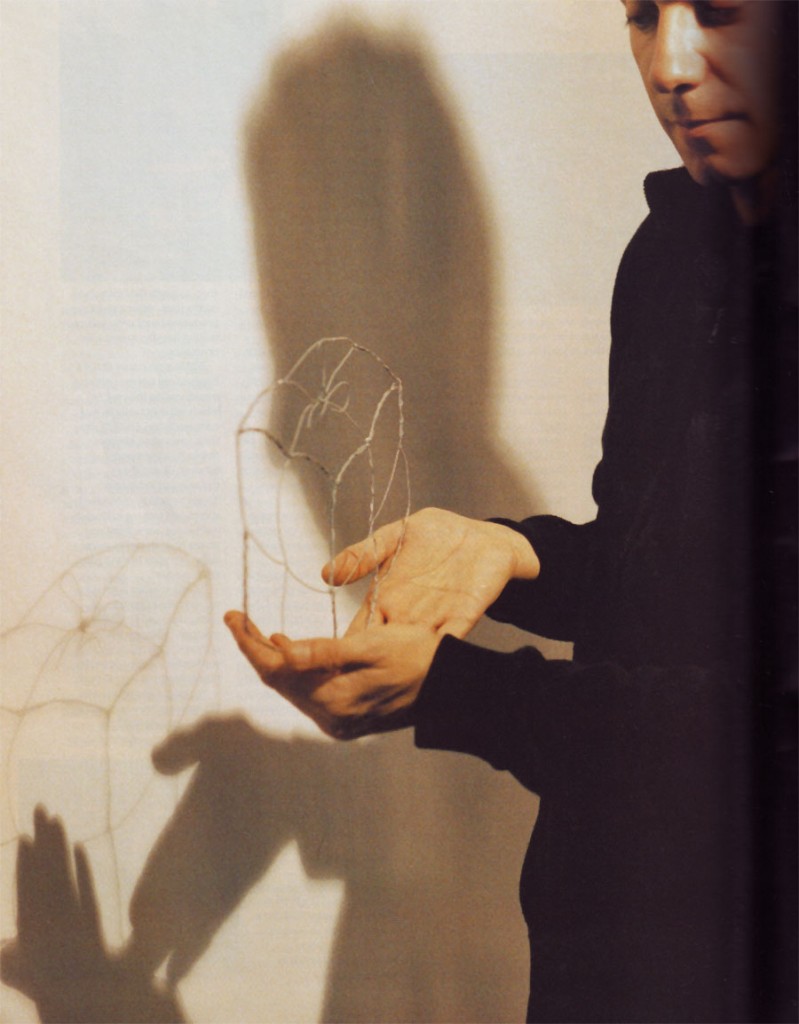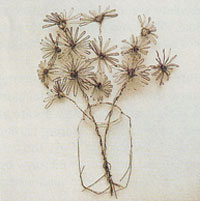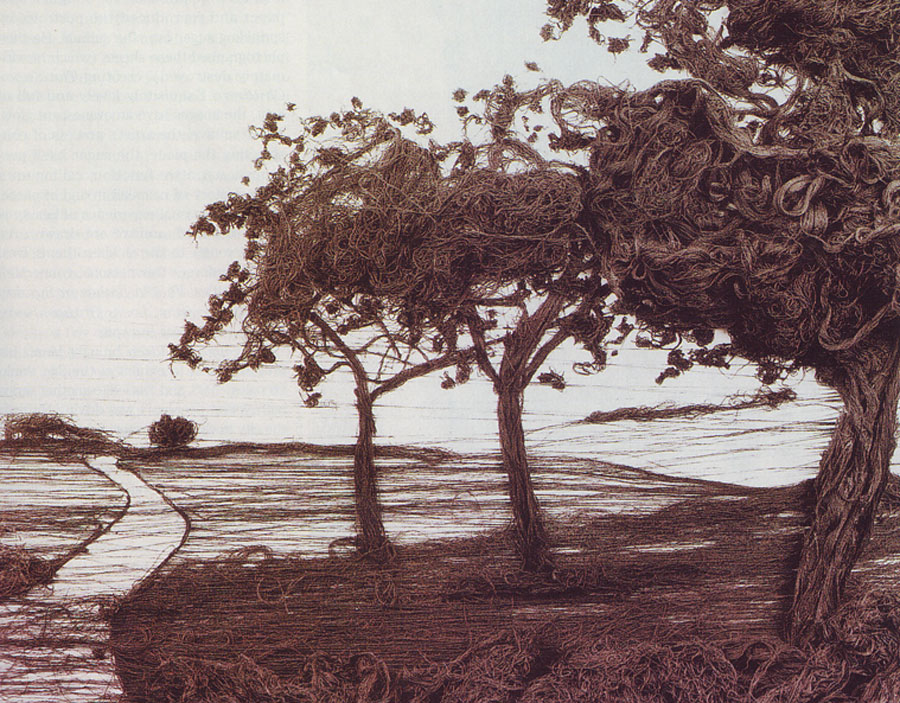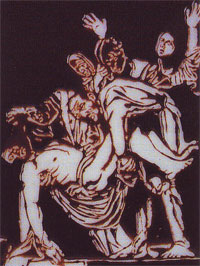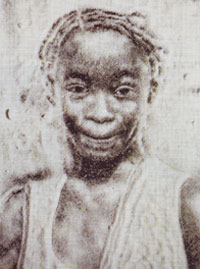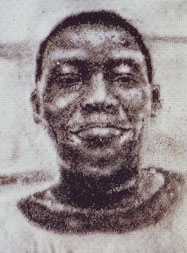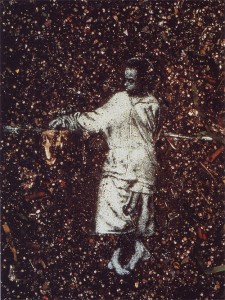Vik Muniz: Between Illusion and Memory
“My mind is bent to tell of bodies changed into new forms,” writes Ovid in his opening to the Metamorphoses. “It is my favorite book; I read it everyday,” says Vik Muniz, who has just quoted the line as we stand in the middle of his large, sun-bright studio. We are surrounded by enormous cameras, whose lens arms extend up and out like industrial cranes; by tables holding several of the Scholars’ Stones whose craglike forms became, in the minds of meditative poets, the cliffs, the mountainsides, the waterfalls that figure in dynasties of Chinese poetry; by Muniz’s own works in progress, including a Rembrandt’s Beggars he is fashioning out of nails.
With a prolific production of drawings, photo-based works, and sculptures, Muniz catapulted to high international regard for his sophisticated way with trompe l’oeil combined with modest, nontraditional materials. He has created compelling images using dirt, leaves, stones, seeds, cotton balls, wire, and even chocolate syrup. Once the image is “set,” Muniz takes a photograph and destroys the “original.” The viewer immediately perceives in the photo the highly realistic image, but it takes a while (often a long while) to recognize the original materials.
Upon first looking at Faucet, we see the basic fixture with a long, slightly curving stream of water; in Summer, we see a delicate strappy dress on a generic hanger; American Tourister depicts a lone suitcase in the middle of a blank page. As we stare at these line drawings, a host of associations and situations come to mind. Staring harder and longer, we realize that what we are literally looking at are Pictures of Wire, the collective name for this series from the mid-1990s. The artist had drawn the pictures by stretching and bending slender wire, which he sometimes twisted to achieve volume and the effects of shadow.
In The Things Themselves: Pictures of Dust, a recent solo exhibition held at New York’s Whitney Museum, Muniz reproduced some seminal works from the 1960s. “Here,” he says, pulling a carton out from under a worktable. Within are several tightly tied, clearly labeled plastic bags, plump with the thick, lumpy, grayish-brown detritus swept and vacuumed up from various sites in the Whitney Museum. We squat down as he opens the bags and peer into the dry, ashy-smelling stuff. “Being curators,” Muniz explains with a smile, “they made a taxonomy of this dust: This bag is from the third floor, this one from the fourth. It is truly disgusting, as you can see, as you can touch. [I didn't.] Most of it is hair and skin. The mortal remains of thousands of museum visitors.”
Thousands of museum visitors indeed flocked to the show to see the beautiful silver-dye bleach prints whose origin was literally dust. To my surprise, Muniz gravitated to lead and steel sculptures: Richard Serra’s Prop, Barnett Newman’s Here III, an untitled Donald Judd made from stainless steel and Plexiglas. Using a most unruly material (“what a mess, never again!”), Muniz achieved not only extraordinary shadow effects, but sharp edges and three-point perspective. Why did he do it? “I am actually trying to shake the dust off these seemingly known images of Minimalist and Postminimalist art.”
Some of the actual pieces were displayed nearby, and to see them again was to see them anew: in both the Serra and the Newman, I was struck by the importance of the shadows they cast on the wall; Judd’s geometry (which I had once found confining) seemed to dance.
“Images are like microbes,” says Muniz who, after art school in his hometown of Sao Paulo, Brazil, worked in advertising. “An image works its way into your subconscious because it connects you to a memory, feeling, or idea. At the same time, you may bypass other things the image might be saying. My work uses a lot of the same tricks, the same techniques employed in commercial media—but in a negative way, because the viewer is intended to realize that the illusion is purely, and often poorly, crafted. I’m always looking for what I call `the worst possible illusion.’ You know you’ve been fooled, and because of it, you develop defenses for deceptive images. I sometimes think of my work as a kind of vaccine. There is a definite ethical structure to what I do as an artist.”
At the same time, the works are fun, buoyant, and witty, unburdened by overt didacticism. The viewer is always in on the joke. “I favor images that are mainstream,” says Muniz, “easy to know. Or images that people don’t feel threatened by, like a landscape or the portrait of a child. Those are particularly good images, because you absorb them, lower your defenses.”
In Pictures of Thread (1995-98), Muniz “replicated” a series of famous landscapes, entitling each work with the measure of its medium: 12,000 Yards (Etretat, after Corot); 17,500 Yards (Landscape without an Angel, after Hagar and the Angel by Claude Lorrain); 16,000 Yards (Le Songeur, after Corot); 4,000 Yards (Apple Trees, after Gerhard Richter). As in earlier series, once the artist completed his picture with thread, he made a photograph, and this is what the viewer—now three steps removed from the original—actually sees. The works are at once precise and atmospheric, and especially accomplished in terms of texture: Muniz’s leaves, bark, waves, rock, and a contemplative human figure are all astoundingly persuasive.
“It’s no harder drawing with thread than with a pencil or ink,” says Muniz, whose art-school training was based, relentlessly, on drafting, modeling, and copying. “You’re just choosing another agent, or actor. The thing with using materials that are unusual or unorthodox is that it focuses a lot of attention on what you’re looking at. If I do this with ink, it’s just a copy of Corot; but if I remove it from the medium of painting, then it’s somehow, magical. You go through two types of recognition: of the painting and the way it is being rendered. It makes you highly conscious of the act of looking, the mechanics of seeing.”
Among the artist’s best known images are those done in the medium of Bosco. “We experimented with all different brands of chocolate syrup,” he tells me. “Bosco has the best consistency. It stays shiny and pliant for about forty-five minutes, so we have to work very fast. It’s a mess, we’re always running and dripping, but somehow we manage.”
One of the most notable pieces in this series, Pictures of Chocolate, is his portrait of Sigmund Freud. The Father of the Talking Cure stares, with solemn toughness, directly at the viewer; how can we not associate orality and prohibition, eroticism and reward, in a rush of sheer pleasure at the artist’s invention? At the same time, we are made to reflect on the darker currents of seduction theory, and on the waves of revision to Freud. In conversation, Muniz refers often to Marshall McLuhan who, in the 1960s, proclaimed “the medium is the message.”
Hence Rembrandt’s Beggars is rendered with nails, which Muniz considers the “syntax” of the work. “It’s an aggressive medium,” explains the artist, running his hand over the half-completed picture, “sharp, pointy, and hard. Using these small nails, I am rendering the Rembrandt very crudely, very sketchy, with lots of little lines. It shows the mechanics of the original, as well as its bite.”
The studio itself is anything but mordant. The atmosphere is at once warm, sociable, and contemplative. Everyone, except myself, is from Brazil. As the sweet rhythms of samba play in the background, the artist’s assistant, Claverson, works at a long, narrow table manipulating thousands of industrial paint samples into a portrait-in-process of the painter Chuck Close. “It was Claverson who figured out how to actually work with that awful dust from the Whitney,” laughs Muniz.
Muniz describes his childhood in Sao Paulo as “extremely, extremely modest.” He has told interviewers that he learned to read from his grandmother, whose formal education lasted no more than eight months. As a boy, Muniz especially loved science and poetry. He kept a journal in which he noted the daily changes in a stain (caused by humidity) on the ceiling above his bed. A seminal event was the night his father—whom he describes as a bartender, gambler, and con man—came home pushing a wheelbarrow loaded with the Encyclopedia Britannica, fourteenth edition, which he had won in a card game. Muniz’s 1989 Big Book is a leatherbound sculpture of the encyclopedia—a meter-high, single-volume tower of learning. The young Muniz pored obsessively over its pages, drawn in as much by the images as by the text.
“I have always loved children,” says Muniz, and indeed some of his most moving and significant pieces reflect this. “The work that really made my career take off was The Sugar Children,” says the artist, referring to a 1996 series of silver gelatin prints that grew out of a highly personal experience on the Caribbean island of St. Kitts. “We met these beautiful, unspoiled children on the beach, played with them, swam with them every day, got to know them, took their pictures. Their parents are cane workers on the plantations, and one day they, too, will be doing hard labor in order to survive. The parents’ lives had made them very tough, very bitter. But the children had this radiance, this purity.”
Valicia, Big James, Jacynthe, and Little Calist all look directly at Muniz’s camera; they are open, composed, and smiling. As he studied his photographs, Muniz was haunted by the sense that their time of innocence was doomed to “melt away.” On a sudden inspiration, he bought black paper and reproduced the portraits by sprinkling sugar over the surface. He then photographed these sheets (which he ultimately destroyed), creating The Sugar Children. Exquisitely lovely and full of light, the images have an evanescent glow. As we unravel the artist’s process of constructing the piece, the sugar itself performs a narrative function, calling up a whole history of colonialism and exploitation. Yet the visual experience of beauty is never dispelled, and we are drawn ever more strongly to the children themselves. Muniz reinforces this personal connection with his titles: Valicia Bathes in Sunday Clothes; Jacynthe, Loves Orange Juice; Big James Sweats Buckets.
The Sugar Children brought Muniz his first invitation to exhibit at the Sao Paulo Bienal, in 1998, and this led to another series with young people. “I was driving through the city to visit the curator and found myself confused,” recalls Muniz. “I knew that there were many abandoned children in Sao Paulo, and yet as I was riding through the streets I didn’t see any of them, not a single one. At the time, I was reading a book by Michael Porter on mimesis and camouflage, and all of a sudden it hit me.” He reaches for a small glass case and hands it to me: I see within a delicate stem and several leaves. “I realized,” says Muniz, pointing at one of the leaves, “that those children were just like this insect. Pure intelligence, evolution in action, the biological genius of camouflage.” We stare for a moment at the wonder of this mimetic bug. “The children,” Muniz continued, “are the same color as the city. They’re dirty, they literally absorb the atmosphere. The upper classes don’t know what to do with them, so to save themselves, they disappear. Because, as you know, these children are chased after, and often killed. It happens every day.”
At the time, Muniz was doing a series he called Pictures of Soil, in which he used dirt (with pebbles, little stems, leaves, bits of shell) to fashion, among other images, Courbet’s Trout, a Torso (after Frantisek Dritkol), and Youth—Gaspar. “I would project an image on a light table covered with soil, so what you see is not there, what you see is pure light. It’s a negative. I thought I could do the same with the hiding children of Sao Paulo, get them to come out, take their pictures. But not,” stresses Muniz, “as a political statement. I think artists make very poor political assessments. Our job as artists is to orchestrate surfaces. I wanted to underline the visual aspects of these children—how they hide, how they appear. What I definitely did not want to do was to make pictures of poor children crying, asking for something. Children must be portrayed with dignity. I wanted to show beautiful children, and to do it somehow with light.”
With a filmmaker friend and a couple of bodyguards, Muniz went searching by night through the streets of São Paulo. “I was afraid they would think we’d come to kill them. Finally, a boy came out, he was very hungry and accepted a hot dog. I could talk to him, I grew up very working class, so we speak the same language. He said he’d come again the next day, and actually came. He was the first one I took a picture of. The next time he brought a friend, and then the friend brought someone. Then we went to a part of town called Crackolandia, because of the drugs, and the kids there were different. Very aggressive. And bruised. They are like a civilization apart, `mole people,’ they don’t even have birth certificates. Their mothers were maybe fourteen, had also always lived in the street. They don’t have names, only nicknames. They’re like the mold of the city. My city.”
Muniz used polaroids so the children could immediately see what he wag doing. He also brought art books, because they had no role models, no sense of what it meant to present an image; they chose figures from Rembrandt and van Gogh and tried to assume that character. Muniz photographed these children on Ash Wednesday, the day after Carnival. “All the excesses, all the crazy things you do are out there in the gutter,” says the artist. “It’s beautiful, a lot of bright paper and glitter and confetti—the gorgeous garbage of Ash Wednesday also makes you feel guilty and sick.” This was the substance he used to make the portraits in the series he officially calls Aftermath. “When they were first being shown, people referred to them as the Garbage Children,” Muniz says, “and I said, No, they are the Light Children. They are made out of light, not garbage.”
The series Aftermath led Muniz to participate in yet another project with Brazilian youth, Projet Axé, in the northeastern city of Salvador. Founded in 1990 on the educational and psychoanalytical principles of Paulo Freire, Jean Piaget, and Jacques Lacan, Axé is a pioneering school for street children. Rigorous and interdisciplinary, the arts are an integral part of the curriculum. “It is a pedagogy of hope and desire,” in the words of Freire, emphasizing that “children have the right to produce their own liberation.” At Axé, it is understood that children have an inalienable right to safety, nutrition, a home, literacy, training, creativity, and community. In order to be part of Axé, students must pledge to come in off the street, make a living arrangement with relatives or responsible neighbors, and undertake a formal program of study, and art or artisanal practice. Axé students have become known for their fashion shows, dance and musical concerts, theater, and art exhibitions. Muniz went to Axé at the invitation of France Morin, former curator of the Museum of Contemporary Art in New York and, since 1997, in charge of bringing artists to Salvador for extended residencies. “The artists must be of the highest quality,” insists Morin, “and have an innate understanding of transgression, in the primal, creative sense, and of the decision to live alone, outside. Otherwise, they will never be able to connect with the children here, will have nothing to offer and nothing to receive.”
For Muniz, Axe was transformative. “With the São Paulo work, I ultimately had no control, there was nothing I could do for those children. To quote Lewis Hine, `they were spoiled human beings.’ It’s a very bad feeling: Most of the children I photographed there are now dead. In Crackolandia, you don’t survive for long.” Salvador, with its beaches and benign climate, was healthier in every way. And drugs didn’t pose such a dire threat.
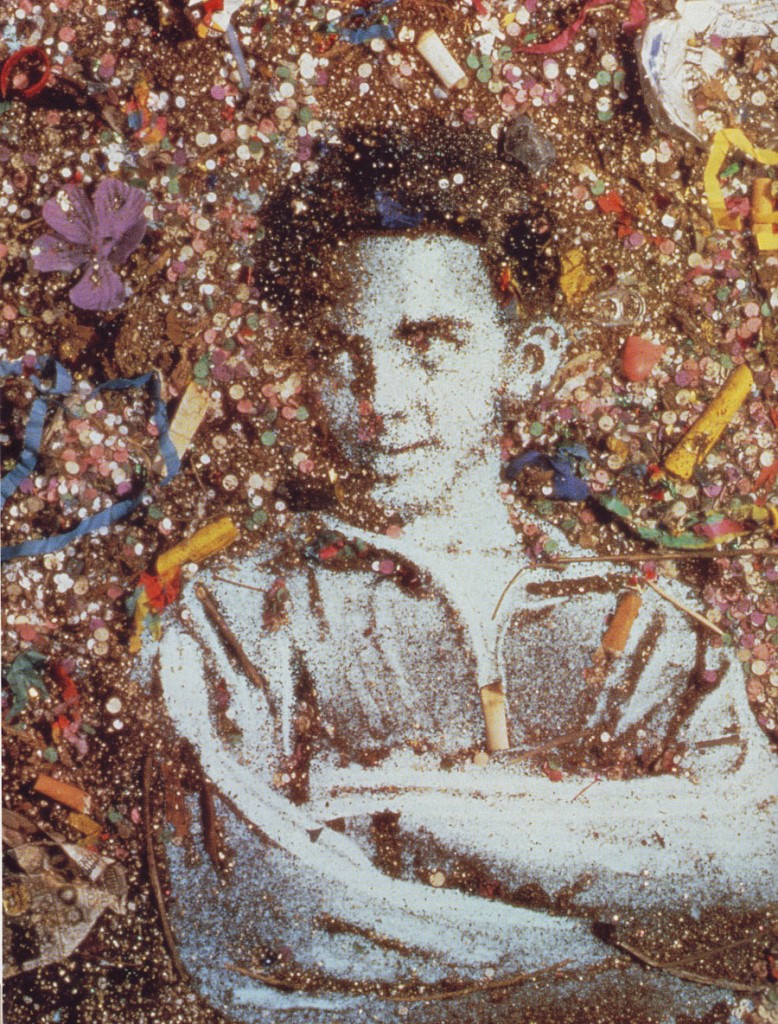
“I soon realized that it was not up to me to bring these children something spiritual. No, I decided to work with materialism, since that’s where their minds were anyway. We did a lot of theater exercises to turn the imagination toward the invisible. Then we had lots of games with the hand—what it could hold, what it could represent, how it can represent weight, volume, and so on. These were very poor, mostly black, children,” says Muniz, “but they have great visual sophistication. They know the names of all the African gods; you cannot say they are uncultivated.” As soon as he showed the group of twenty-two students a statue by Giacometti, The Invisible Object (sometimes called Figure Holding a Void), which shows a figure attached to a frame, they immediately recognized its debt to African art. “Children understand sculpture much better than adults,” Muniz is convinced. “Right away, they saw bondage, deprivation, wanting.”
“So I asked them, Is there something you want and cannot have? All of them said, yes. If you could have the thing you most wanted, something that could fit in your hand, what would it be? And they started thinking, and `feeling’ it in their hand and describing what it was like to have it. We filmed all this—their hands moving against colorful backgrounds. And then by drawing or modeling or some other way, they had to make the object of their desire, to scale so they could hold it. They made musical instruments—a small ukelele, a tambourine, a kind of accordion—a little house, a magic lamp, one made a wad of cash, another a bag of money, lots of little magic things, a flying carpet. Then they put these twenty-two objects in a black bag and closed it forever. As we watch the videotape, there is no way of knowing what is in the bag. They are showing you what you can’t have, because they’re holding it inside their minds. Usually, it’s the other way around—they must confront the goods and products and services they cannot have. This time, they turn the tables, they are the ones producing desire.”
Muniz says he cried when he left Axé and is eager to return. “Two of the kids in that group now work in a painter’s studio in the afternoons,” he says, with evident pride.
The artist hopes his newest project, The Seven Colors, will have an immediate direct benefit for the children involved. “In India,” he told me, “they can produce all the colors of the rainbow using spices. The ones who do this are young girls, who never go to school and live out their short lives in the bazaars and markets, breathing in the toxic spice dust. Our idea—which has just received funding from UNICEF—is to make portraits of these girls, rather like The Sugar Children, but with the very spices that both sustain and will eventually kill them. We hope to sell these portfolios and get the money to the girls quickly enough to save them, to help them change their lives.”
Muniz and I pace slowly through his studio, walking carefully between his equipment, worktables, and displays. “In response to your first question about all these cameras,” he says, now that we are all but finished, “it’s about light coming in to a surface, impregnating the surface with the substance of the outside world. There are so many transformations, so many metamorphoses, I simply cannot give it up yet for something more `modern,’ or `technological.’ Light coming through a piece of glass is almost a ritual. It sends you messages. I still think that artists are very close to shamans in this sense, we’re creating mechanisms of faith. Shamans were always involved with bringing the spirit of something into something else. What people don’t understand is that all this has to do with presentation. It is so powerful that you actually feel it in your body, your entire body, you’re illuminated. It’s been said that God speaks through saints or the images of saints. I don’t think so. God is pure light, it’s not reflective, it’s everywhere, and it’s alchemical.”

